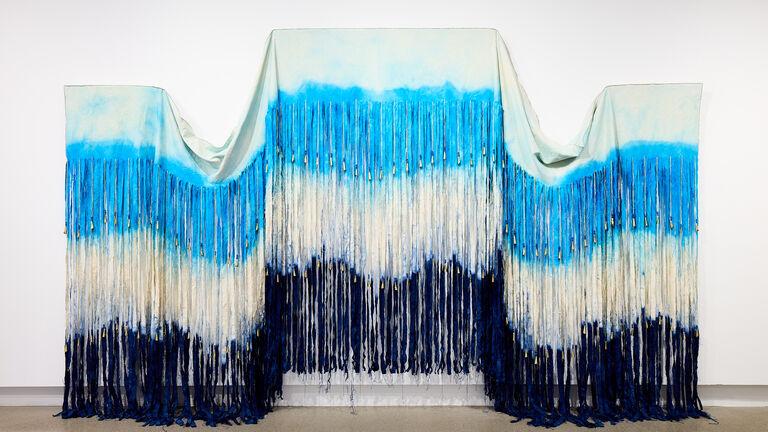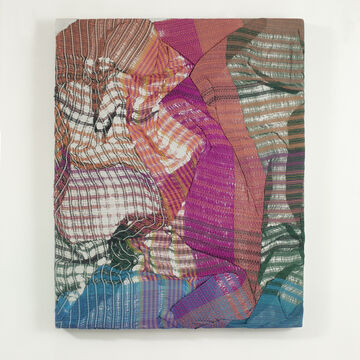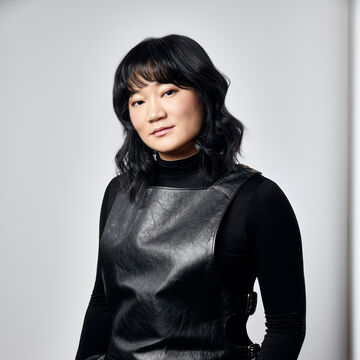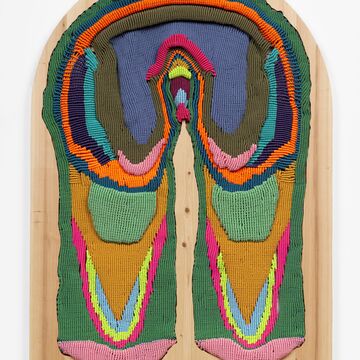
Photo Credit: Tony Favarula
Artwork by Chelsea Bighorn
Alumni
Alumni
Are you an SAIC Fiber & Material Studies graduate?
Share your professional accomplishments with us by filling out the FMS Alumni News form.

Photo Credit Rob Southard.
Embody 1, 2021
Handwoven cast in concrete
Weaving / casting
Mercerized cotton
30in x 24in x 2in
Crystal Gregory
Crystal Gregory is a sculptor whose work investigates the intersections between textile and architecture. Gregory received her BFA from the University of Oregon and her MFA from The School of the Art Institute of Chicago from the Fiber and Material Studies Department. In 2013 she was awarded The Leonore Annenberg Fellowship for the Performing and Visual Arts. With this grant she moved to Amsterdam, where she took a role as Guest Artist at The Gerrit Rietveld Academie of Art. Her work has been exhibited in museums and galleries nationally and internationally including Through the Thread at the Rockwell Museum of Art, Devotion/Destruction: Craft Inheritance at Dorsky Gallery Curatorial Projects, Load Barring: The Art of Construction at The Hunterdon Art Museum, and Bodies at Rest, Brookfield Properties, Brooklyn Commons. Gregory’s work has been reviewed in publications such as Hyperallergic, Surface Design Journal, Art Critical, and Peripheral Vision Press, and incorporated into Al Shand’s collection and the US Embassy in Sri Lanka. Gregory is an Associate Professor within the School of Arts and Visual Studies and has recently been titled the Arturo Alonzo Sandoval Endowed Professorship in Fiber at the University of Kentucky. Gregory currently shows with Tappan Collective in Los Angeles, CA; Imlay Gallery; and Momentum Gallery, NC.

Courtesy of the artist. Fafnir Adamites.
Fafnir Adamites
Using weaving, papermaking, and basketry, I create sculptures that act as monuments and reminders of trauma, intuition, and the legacy of emotional turmoil inherited from past generations. I work mainly with materials which I call “chaos structures.” Unlike a woven textile which is grounded in an orderly grid, chaos structures are open-ended and are based on a disorderly foundation. A powerful transformation takes place in a process like papermaking when the millions of chaotic fibers bind together to make a strong, cohesive, singular piece. The conceptual depth rooted in these materials relates to my interest in reclaiming personal intuition and agency within the chaotic landscape of trauma.
Fafnir Adamites (they/them) holds an MFA degree from the Fiber and Material Studies Department at the School of the Art Institute of Chicago and a BA in Photography and Women’s Studies from UMass Amherst. Fafnir is an Assistant Professor and Head of the Fiber Area at California State University, Long Beach and has taught workshops and intensives at Arrowmont School of Art and Craft, Snow Farm: The New England Craft Program and Women’s Studio Workshop. Their work has been shown nationally, including a recent juried exhibition at Craft Contemporary in Los Angeles called Tactics of Erasure and Rewriting Histories. Fafnir has received several grants to support their exhibitions and studio practice and has been awarded residencies at MASS MoCA, Women’s Studio Workshop, and Vermont Studio Center. They are a board member and co-chair of the Surface Design Association and a member of North American Hand Papermakers.

Photo Credit Yeva Dashevsky.
Hope Wang
Hope Wang is a multimedia artist and creative entrepreneur based in Chicago, IL. She is the founding director of LMRM “loom room,” a project space working to broaden accessibility to digital weaving equipment for fiber artists in Chicago. Through LMRM, Wang develops events and collaborations that emphasize weaving as a contemporary art practice. Wang was also a founding organizer of Chicago Textile Week 2019 and 2021, a cross-disciplinary exposition connecting and strengthening textile communities throughout the city.
In the studio, her artwork explores memory, loss, and longing in the ever-shifting architectural landscape. Her practice encompasses painting, prints, photo collages, poetry, and textiles. Most recently in 2023, she was awarded a Visual Arts Fellowship from the Luminarts Cultural Foundation, as well as a Chicago Community Fellowship Fund from the Breakout Foundation. Wang was also a 2021 recipient of the gener8tor Art Accelerator Grant and a 2022 DCASE Chicago recipient of an Individual Artist Grant. Her work has been exhibited throughout the Midwest and beyond, which most recently includes the Villa Terrace Decorative Arts Museum in Milwaukee, WI and the Chinese American Museum of Chicago, IL. She has attended the Digital Weaving Lab Residency at Praxis Fiber Workshop (Cleveland, OH); The Weaving Mill WARP Residency (Chicago, IL); and Spudnik Press Cooperative Fellowship (Chicago, IL). Wang holds a BFA from The School of the Art Institute of Chicago.

Courtesy of the artist. Jesse Harrod, Nothing is dead down here, 2023.
Jesse Harrod
Jesse Harrod (she/they) is a multidisciplinary artist living and working between Philadelphia, PA, and New York, NY. Their visual art practice encompasses sculpture, painting, stop-motion animation, and other media to reimagine forms of gendered, sexual, and disabled embodiment.
Harrod’s latest solo exhibition, Tough Nut, was presented by Fleisher/Ollman Gallery in 2023. In 2021, Harrod was commissioned by the John Michael Kohler Arts Center to create a work responding to the Eugene Von Bruenchenhein collection in the center's Art Preserve. In 2020, they were awarded a Visual Arts Fellowship by the Pew Center for Arts & Heritage, as well as a Temple University Faculty Award for Creative Achievement.
Harrod’s solo exhibitions include Hatch, Bowtie Projects, Los Angeles, CA; Mother Mascots, Drake Hotel, Toronto, Canada; Flaggin’ 1,2,3, Socrates Sculpture Park, Queens, New York; Rope, Hangaram Art Museum, Seoul, South Korea; Low Ropes Course, NurtureArt, Brooklyn, NY; and Toxic Shock and Hotdog, Vox Populi, Philadelphia, PA among others. In 2019, Fleisher/Ollman presented Mending and Repair in Response, a two-person exhibition featuring Harrod and Lisi Raskin. Harrod has been featured in group exhibitions such as In Practice: Material Deviance, SculptureCenter, NY; the traveling exhibition Queer Threads: Crafting Identity and Community, organized by Leslie-Lohman Museum of Art, New York, NY; Even Thread Has a Speech, the John Michael Kohler Arts Center, Sheboygan, WI; and String Along at Antenna Gallery, New Orleans, LA.
Harrod has been awarded residencies at the John Michael Kohler Arts Center's Art/Industry program; Fire Island Artist Residency; the Open Studio Residency at Haystack Mountain School of Craft; the Icelandic Textile Center; the Vermont Studio Center; Ox-Bow Artist’s Residency; RAIR, Philadelphia; Banff Centre for Arts and Creativity; and the Museum of Art and Design, among others.
Harrod was born in South Africa and raised in Canada, before moving to the United States to pursue their MFA at the School of the Art Institute of Chicago. Harrod has an MFA from the Department of Fiber & Material Studies at the School of the Art Institute of Chicago and a BFA from the Nova Scotia College of Art and Design University. They are currently the Head of Fibers & Material Studies at Tyler School of Art, Temple University, Philadelphia.

Courtesy of the artist. María José Murillo.
María José Murillo
María José Murillo is a textile artist and researcher, co-founder and member of art collective Noqanchis. Murillo holds a BFA in Painting from Pontificia Universidad Católica del Perú – PUCP (2006-2011) and a Master of Fine Arts (MFA) degree in Studio through the Fiber and Material Studies department at the School of the Art Institute of Chicago – SAIC (2017-2019). Upon finishing her graduate studies, she moved to the Andes to work under the guidance of Nilda Callañaupa, founder of the Centro de Textiles Tradicionales del Cusco – CTTC and was entrusted with the institution’s Education Department. In 2022, she took part in the WIELS contemporary art residency in Brussels (Belgium) after landing the ICPNA Artus WIELS scholarship. Since 2023, she has been a member of the Textile Society of America – TSA Board of Directors, where she is part of the Committee for Diversity, Equity, and Inclusion. She was recently selected to participate in the research residency for art experimentation Recherches 2024 at TAMAT – Musée de la Tapisserie et des Arts Textiles in Tournai, Belgium.
Solo exhibitions include: Con otros ojos para ver / With other eyes to see. ICPNA, Lima (2023); Transición / Transition at Revolver Gallery, Lima (2015) and Proliferar / Proliferate, Centro Colich (2012).
Group exhibitions include: (Upcoming with Noqanchis collective) On loss and Absense: Lives and Legacies of Textiles. Art Institute of Chicago – AIC, Chicago (2025); (Upcoming) Naming Natures. Muséum d’Histoire Naturelle Neuchâtel – MHNN, Switzerland (2024); Textiles del futuro: redes de diálogo y colaboración en torno al arte textil latinoamericano, La Escuela___, digital platform (2023); Ser Pallay. ICPNA, Lima (2023); Ser Pallay, collaborative textile art project. Vigil Gonzales Gallery, Cusco (2021); Ser Sur, Chuquimarca Projects, Chicago (2019); (dis)comfort zones: Underrepresentation and Invisibility in the Institution, WI, USA (2019); A Bringing Across. Art Institute of Chicago – AIC; Chicago (2018), Tie it Off & Count Again. Hamilton Audio Visual Node, ON, Canada (2018) and FACE 1. Revolver Gallery, Lima (2013).
Her work is part of the following publications: “Con otros ojos para ver”, ICPNA-Artus. Lima, 2024; “Ser Pallay”, ICPNA. Lima, 2023; “A Return Throught the Origins of Modernity”, TEXTILE: Cloth & Culture, Taylor and Francis, 2021; Tejido, arte y feminismos: “Urdiendo el pasado, tramando el futuro”, Arte Mujeres Ecuador – AME, 2021; “Tie it Off & Count Again”, Audio Visual Node. Hamilton, 2018 and “Seventy Seven Contemporary Peruvian Artists”, Museo Mario Testino – MATE, Lima, 2017.
Papers/lectures presented at conferences include: Ser Pallay, Pinta PArC, Lima (2023); A Return Throught the Origins of Modernity, WIELS Centre d’Art Contemporain, Brussels (2022); A Return Throught the Origins of Modernity, Atelier Design Textile, La Cambre, Ecole nationale supérieure des arts visuels, Brussels (2022); Noqanchis Awaqkuna with Noqanchis Colective, Mitchell Lecture Series, Fiber and Material Studies Department, School of the Art Institute of Chicago – SAIC (2021); María José Murillo, Corriente Alterna Art School, Lima (2021); The Present, the Presence, Grad Lecture Series II, Fiber and Material Studies Department, School of the Art Institute of Chicago – SAIC (2019); and Ecos de mi alma mestiza, Grad Lecture Series I, Fiber and Material Studies Department, School of the Art Institute of Chicago – SAIC (2019).
She has received recognitions and grants such as: Recherches24 residency at Museé de la Tapisserie et des Arts Textiles – TAMAT (2023); ICPNA-Artus Grant to participate in the WIELS Residency 2022 (2020); Pritzker Merit Scholarship, School of the Art Institute of Chicago – SAIC (2017) and the first place in the FACE 1 competition for emerging Peruvian artists organized by Revolver Gallery (2013).
María José Murillo (1989, PE) is an artist and cultural worker researching and reviving ancient Andean and Quechua weaving cultures through textile, collages, drawings, and ceramics.
Within her work, she uses ancestral weaving traditions in combination with modern techniques and materials, to explore her heterogeneous cultural identity (which she refers to as mestizaje ch'eqchi) and to enter into a relation with her ancestors.
Foundational for Murillo’s practice was the realization of how the art and legacy of the Peruvian textile culture have been completely erased from the artistic educational system in Peru. After a BFA in Painting at Pontificia Universidad Católica del Perú in Lima, she followed an MFA in Fiber and Material Studies at the School of the Art Institute of Chicago. It was only during her master's program in the US that she learned about the great ancestral weavers of the Andean region through a Western lens: learning to weave under Anni Albers legacy, reading books on textiles and visiting textile archives only available there. In Peru, she was only introduced to a Eurocentric view of arts and culture where the emphasis was on painting on canvas. Traditional materials such as plant or animal fibers, as well as processes such as weaving and natural dyeing, have been largely excluded due to a hierarchical differentiation between craft and modern or contemporary western art.
Since 2017 her practice shifted from creating sculptural work to researching the diaspora of textiles from Peru to Western institutions, reflecting on how the colonial system has perpetuated the dominant western culture against the indigenous, as well as on weaving as a tool for reclaiming her cultural identity. After her MFA, she settled in Cusco where she became the head of the education department of the Centro de Textiles Tradicionales del Cusco. This organization rescues and revitalizes the textile traditions of Peru's ancestors. To further empower her community, she founded the union of textile artists Noqanchis (2021) with other well-known young weavers from the Peruvian Andes.
“As a Peruvian artist, I listen to the voice of that presence, the present. I listen to it, talk to it, decode it, express it ... Weaving is my language. In its grid, past and future are omnipresent so that my work transcends the individual and becomes something collectively. It allows me to unravel my state of systematized "division" and weave the contradictions together.” – María José Murillo
Collective Noqanchis Biography
Noqanchis is an art collective created in 2021 by Alipio Melo, Danitza Willka, and María José Murillo. Rooted in the essence of Andean weaving, their purpose is to intertwine their worldview and experiences as contemporary textile artists.
Alipio Melo (Pitumarca, 1989) blazed his path as the only male weaver artist of his community since the age of seven, challenging gender stigmas. His determination and passion for weaving have made him one of the most renowned weavers in the Cusco region.
Danitza Willka (Pitumarca, 2001) inherited her passion for weaving from mother Ana and grandmother Epifania. Her last name, Willka translates as “sacred,” “granddaughter,” and “tree.” Despite her being unable to find a career tailored to her nature as a weaver, she majored in Food Industries. Weaving, however, is the living force that sees her through in the day-to-day.
The ancestral language of Andean textile found María José Murillo (Arequipa, 1989) as she coursed the Fiber and Material Studies MFA program at the School of the Art Institute of Chicago (SAIC). Through textiles, she undertook a path of reclamation and search for her indigenous cultural heritage, which was excluded from the Eurocentric education she received as an art student in Peru.
Noqanchis is Quechua for “all of us.” It’s an inclusive us that is different from noqayku, a restrictive us. Unlike Western languages, Quechua employs the same root for “I” (noqa) and “us” (noqanchis / noqayku), revealing the inseparable bond that exists between the individual and the community in the construction of Andean identity.
Disclaimer: All work represents the views of the individual artists and authors who created them and are not necessarily reflective of the School or museum of the Art Institute of Chicago.